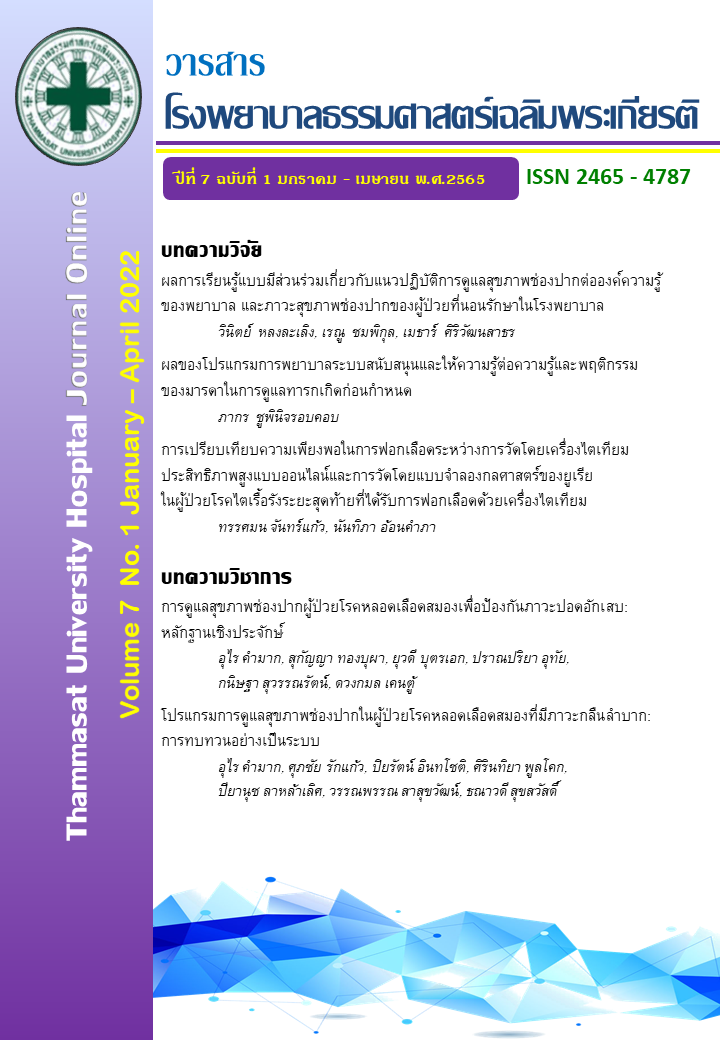Effects of Active Learning in Oral Health Care Practices on Body of Knowledge in Nurses and Oral Health Care in hospitalized Patients
Keywords:
Oral health care, Oral health care for intubated patients, Clinical nursing practice guideline of oral health care, Evidence-based nursing practice, Active learningAbstract
Background: Oral care of patients is an additional role of the nurse. It reduces the number of microorganisms in the oral cavity and makes the patient feel comfortable. Based on a lot of studies, oral care guidelines reduce the incidence of respiratory infection. Therefore, knowledge and practice of oral health care active learning program is important to nurses.
Objective: This study aims to determine the knowledge, skill, and satisfaction for nurses in active learning program of oral health care and effectiveness of oral health care guideline for patients.
Material and Methods: This quasi-experimental study consists of 2 phases, to begin with training 837 volunteered nurses in oral health care active learning program at Thammasat University Hospital and also assess the knowledge, skill, and satisfaction with appropriate assessment form. In addition to determine the effectiveness of an oral health care guideline, 70 patients were purposively selected and assessed about oral health 2 times, before and after. The data were analysed with descriptive and t-test statistics.
Result: After training with an oral health care active learning program, registered nurses had high score of knowledge, skill, and satisfaction when compared with pre-test. While the assessment of oral health care on patients with an oral health care guideline was significantly clean or healthier than baseline.
Conclusion: The oral health care in clinical nursing practice guideline and active learning program is effective to improve the oral care knowledge, skill and satisfaction of registered nurses. It also maintains oral health in patients. An oral health care guideline should be used by nursing organizations to promote patient’s oral health care in a sustainable way.
References
Paster, BJ, Boches SK, Galvin JL, Ericson RE, Lau CN, Levanos VA, Sahasrabudhe A, Dewhirst FE. Bacterial diversity in human subgingival plaque. J Bacteriol 2001; 183: 3770 -3783.
จินตกร คูวัฒนสุชาติ. จุลชีววิทยาช่องปากและที่มาของโรคฟันผุ โรคปริทันต์และโรคในช่องปาก. กรุงเทพ: โรงพิมพ์แห่งจุฬาลงกรณ์มหาวิทยาลัย; 2549.
Scannapieco, FA, Stewart, EM & Mylotte, JM. Colonization of dental plaque by respiratory pathogens in medical intensive care patients. Crit. Care Med 1992; 20: 740-45.
Scannapieco FA. Pneumonia in nonambulatory patients; the role of oral bacteria and oral hygiene. J Am Dent Assoc 2006;137 Suppl: 21S-5.
สุปาณี เสนาดิสัย, วรรณภา ประไพพานิช. การพยาบาลพื้นฐาน: แนวคิดและการปฏิบัติ. พิมพ์ครั้งที่ 10. ภาควิชาพยาบาลศาสตร์ โรงเรียนพยาบาลรามาธิบดี. กรุงเทพมหานคร; 2547.
Hanneman SK, Gusick GM. Frequency of oral care and positioning of patients in critical care: a replication study. Am J Crit Care 2005; 14(5): 378-86.
Jones H, Newton JT, Bower EJ. A survey of the oral care practices of intensive care nurses. Intensive Crit Care Nurs 2004; 20(2): 69-76.
Mori H, Hirasawa H, Oda S, Shiga H, Matsuda K, Nakamura M. Oral care reduces incidence of ventilator-associated pneumonia in ICU populations. Intensive Care Med 2006; 32(2): 230-6.
Stiefel KA, Damron S, Sowers NJ, Velez L. Improving oral hygiene for the seriously ill patient: implementing research-based practice. Medsurg Nurs 2000; 9(1): 40-3.
Ross A, Crumpler J. The impact of an evidence - based practice education program on the role of oral care in the prevention of ventilator - associated pneumonia. Intensive Crit Care Nurs 2007; 23(3): 132-6.
Soh KL, Ghazali SS, Soh KG, Raman RA, Abdullah SSS, Ong SL. Oral care practice for the ventilated patients in intensive care units: a pilot survey. J Infect Dev Ctries 2012; Apr 13; 6(4): 333-9.
วินิตย์ หลงละเลิง, นรลักขณ์ เอื้อกิจ. ผลของแนวปฏิบัติการพยาบาลการดูแลช่องปาก สำหรับผู้ป่วยที่ใส่ท่อทางเดินหายใจในภาวะวิกฤต. วารสารพยาบาลโรคหัวใจและทรวงอก 2559; มกราคม- มิถุนายน; 27(1): 98-113.
Soukup, SM. The center for advanced nursing practice evidence-based practice model: promoting the scholarship of practice. Nurs Clin North Am 2000; 35(2): 301-9.
นิศาชล โชคะสุต, ธีระเดช ธรรมจำรัส, มัทนา เกษตระทัต, ณัฏฐิรา สุขสุเดช, วินิตย์ หลงละเลิง. ผลของโปรแกรมการฝึกอบรมพยาบาล เพื่อดูแลสุขภาพช่องปากผู้ป่วยในแผนกวิกฤต โรงพยาบาลธรรมศาสตร์เฉลิมพระเกียรติ. คณะทันตแพทย์ศาสตร์ มหาวิทยาลัยธรรมศาสตร์; 2561.
Bonwell CC, James AE. (1991). Active Learning; Creating Excitement in the Classroom. ASHE-ERIC Higher Education Report No. 1. Washington, D.C: The George Washington University, School of Education and Human Development; 1991.
Eilers J, Berger AM, Petersen MC. Development, testing, and application of the oral assessment guide. Oncol Nurs Forum 1988; 15(3): 325-30.
Krebs EE, Carey, TS, Weinberger, M. Accuracy of the pain numeric rating scale as a screening test in primary care. JGIM 2007.; 22: 1453-58.
Mori H, Hirasawa H, Oda S, Shiga H, Matsuda K, Nakamura M. Oral care reduces incidence of ventilator- associated pneumonia in ICU populations. Intensive Care Med 2006; 32(2): 230-6.
เทื้อน ทองแก้ว. เอกสารประกอบการอบรมการเรียนรู้แบบมีส่วนร่วม. กรุงเทพมหานคร: สถาบันราชภัฏจันทร- เกษม; 2546.
Booker S, Murff S, Kitko L, Jablonski R. Mouth care to reduce ventilator-associated pneumonia. Am J Nurs 2013; 113(10): 24-30.
Downloads
Published
How to Cite
Issue
Section
License
Copyright (c) 2022 Thammasat University Hospital Journal Online

This work is licensed under a Creative Commons Attribution-NonCommercial-NoDerivatives 4.0 International License.



